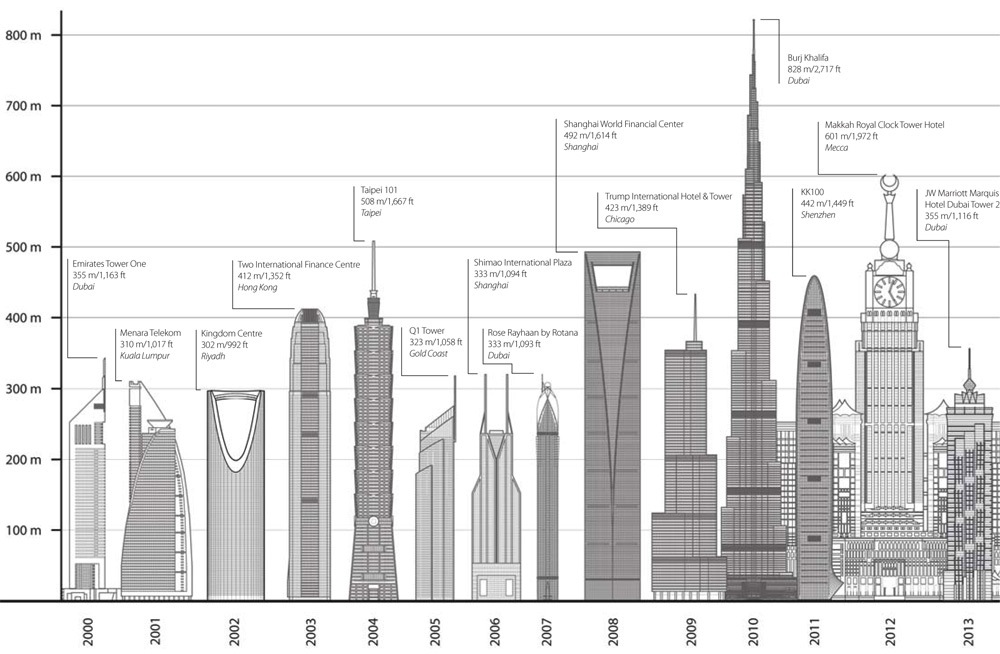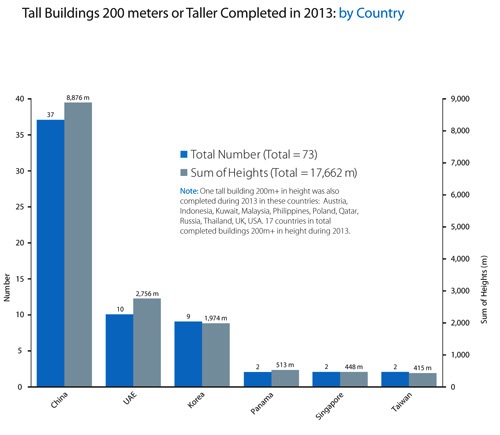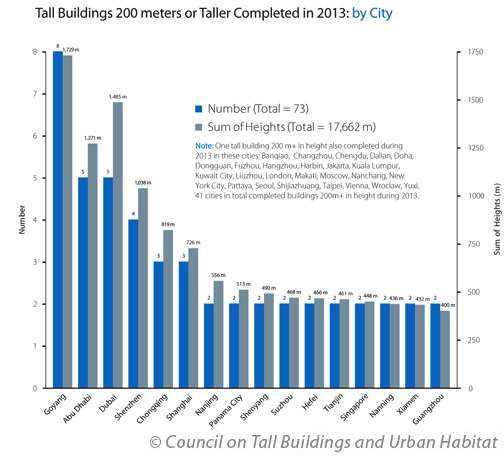While 2013 didn't see the completion of a mega tower like Burj Khalifa, it was a near-record-setting year in terms of the number of super-tall skyscrapers completed.
Led by the 82-story, 1,166-foot JW Marriott Marquis Hotel Dubai Tower 2, a total of 73 buildings of 200 meters or greater height were built in 2013. It was the second-busiest year ever, behind only 2011, when 81 super-tall projects opened, according to a report by the Council on Tall Buildings and Urban Habitat (CTBUH).
Last year also saw the completion of nine 300-meter-plus towers. In fact, nearly half (47%) the world's 77 300-meter-plus skyscrapers were completed during the past four years.
The top 10 skyscrapers completed in 2013 are:
1. JW Marriott Marquis Hotel Dubai Tower 2, Dubai, UAE (82 stories, 355 meters, 1,166 feet)
2. Mercury City Tower, Moscow, Russia (75, 339, 1,112)
3. Modern Media Center, Changzhou, China (57, 332, 1,089)
4. Al Yaqoub Tower, Dubai, UAE (69, 328, 1,076)
5. The Landmark, Abu Dhabi, UAE (72, 324, 1,063)
5. Deji Plaza, Nanjing, China (62, 324, 1,063)
7. Cayan Tower, Dubai, UAE (73, 307, 1,008)
8. East Pacific Center Tower A, Shenzhen, China (85, 306, 1,004)
8. The Shard, London, UK (73, 306, 1,004)
10. Dongguan TBA Tower Dongguan, China (68, 289, 948)
See the full list

Tall buildings 200 meters or taller completed each year from 1960 to 2014 © CTBUH (click image to enlarge)
Other milestones from 2013, according to the CTBUH report:
• Across the globe, the sum of heights of all 200-meter-plus buildings completed globally in 2013 was 17,662 meters – also the second-ranked in history, behind the 2011 record of 21,642 meters.
• Of the 73 buildings completed in 2013, 12 – or 16 percent – entered the list of 100 Tallest Buildings in the World.
• For the sixth year running, China had the most 200-meter-plus completions of any nation, at 37 – located across 22 cities.
• Three of the five tallest buildings completed are in the United Arab Emirates, for the second year in a row.
• The city of Goyang, Korea, has debuted on the world skyscraper stage with eight 200-meter-plus buildings completing in 2013.
• Europe has two of the 10 tallest buildings completed in a given year for the first time since 1953.
• Panama added two buildings over 200 meters, bringing the small Central American nation’s count up to 19. It had none as recently as 2008.
• Of the 73 buildings over 200 meters completed in 2013, only one, 1717 Broadway in New York, was in the U.S.
For the full report, visit: http://www.ctbuh.org/TallBuildings/HeightStatistics/AnnualBuildingReview/Trendsof2013/tabid/6105/language/en-US/Default.aspx

The tallest building completed each year since the year 2000. © CTBUH (click image to enlarge)

© CTBUH (click image to enlarge)

© CTBUH (click image to enlarge)
Related Stories
| Aug 8, 2022
Mass timber and net zero design for higher education and lab buildings
When sourced from sustainably managed forests, the use of wood as a replacement for concrete and steel on larger scale construction projects has myriad economic and environmental benefits that have been thoroughly outlined in everything from academic journals to the pages of Newsweek.
AEC Tech | Aug 8, 2022
The technology balancing act
As our world reopens from COVID isolation, we are entering back into undefined territory – a form of hybrid existence.
Legislation | Aug 5, 2022
D.C. City Council moves to require net-zero construction by 2026
The Washington, D.C. City Council unanimously passed legislation that would require all new buildings and substantial renovations in D.C. to be net-zero construction by 2026.
Cultural Facilities | Aug 5, 2022
A time and a place: Telling American stories through architecture
As the United States enters the year 2026, it will commence celebrating a cycle of Sestercentennials, or 250th anniversaries, of historic and cultural events across the land.
Sponsored | | Aug 4, 2022
Brighter vistas: Next-gen tools drive sustainability toward net zero line
New technologies, innovations, and tools are opening doors for building teams interested in better and more socially responsible design.
| Aug 4, 2022
Newer materials for green, resilient building complicate insurance underwriting
Insurers can’t look to years of testing on emerging technology to assess risk.
Sustainability | Aug 4, 2022
To reduce disease and fight climate change, design buildings that breathe
Healthy air quality in buildings improves cognitive function and combats the spread of disease, but its implications for carbon reduction are perhaps the most important benefit.
Multifamily Housing | Aug 4, 2022
Faculty housing: A powerful recruitment tool for universities
Recruitment is a growing issue for employers located in areas with a diminishing inventory of affordable housing.
Multifamily Housing | Aug 3, 2022
7 tips for designing fitness studios in multifamily housing developments
Cortland’s Karl Smith, aka “Dr Fitness,” offers advice on how to design and operate new and renovated gyms in apartment communities.
Building Materials | Aug 3, 2022
Shawmut CEO Les Hiscoe on coping with a shaky supply chain in construction
BD+C's John Caulfield interviews Les Hiscoe, CEO of Shawmut Design and Construction, about how his firm keeps projects on schedule and budget in the face of shortages, delays, and price volatility.

















